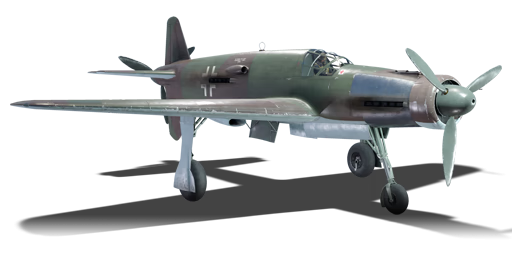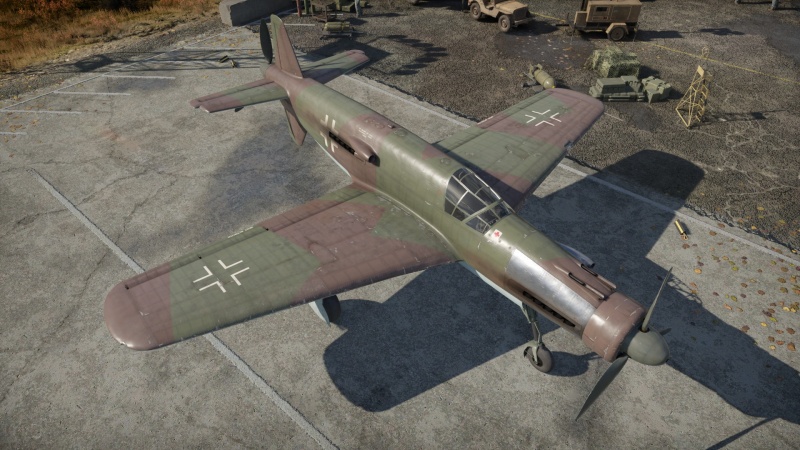Do 335 A-1
| This page is about the German strike aircraft Do 335 A-1. For other variants, see Do 335 (Family). |
Contents
Description
The Do 335 A-1 is a rank III German strike aircraft with a battle rating of 4.0 (AB), 4.3 (RB), and 5.0 (SB). It was introduced in Update 1.57 "Battle March".
The Do 335 is a difficult plane to fly. It has good armament, however, lacks anything else of substance. Sub-par climb, bad turning, and handling, as well as the lack of armor and a propensity to catch fire make this aircraft a very difficult grind. Pilots should utilize the air spawn, then climb as high as possible and go after bombers. Once available, the air belts are devastating against bombers; however, as the plane lacks armor and catches fire quickly, tailing should be avoided. It is also possible to Boom & Zoom with, however, the plane tends to veer off target in prolonged dives.
Contrary to popular belief the Do 335 Pfeil is not a super prop. The initial design was a Schnellbomber (speedy bomber), but with the start of the emergency fighter program, most bomber contracts were shelved to increase fighter production. At Dornier, the idea arose to reconfigure the current bomber design into a heavy fighter to exploit the failure of Focke Wulf's Ta 154 Moskito.
Consequently, flight agility is mediocre, lending itself in feeling to Dornier's previous heavy fighters: Do 17 Z-7 and Do 217N. Both of which were coincidentally bombers by birth too. The exception to this trait is the fantastic roll-rate, accomplished by boosted ailerons as seen on the Ta 152H-1.
General info
Flight performance
| Characteristics | Max Speed (km/h at 7,000 m) |
Max altitude (metres) |
Turn time (seconds) |
Rate of climb (metres/second) |
Take-off run (metres) | |||
|---|---|---|---|---|---|---|---|---|
| AB | RB | AB | RB | AB | RB | |||
| Stock | 727 | 709 | 11400 | 27.3 | 28.3 | 9.5 | 9.5 | 464 |
| Upgraded | 784 | 755 | 24.8 | 26.0 | 16.9 | 12.9 | ||
Details
| Features | ||||
|---|---|---|---|---|
| Combat flaps | Take-off flaps | Landing flaps | Air brakes | Arrestor gear |
| X | ✓ | ✓ | X | X |
| Limits | ||||||
|---|---|---|---|---|---|---|
| Wings (km/h) | Gear (km/h) | Flaps (km/h) | Max Static G | |||
| Combat | Take-off | Landing | + | - | ||
| 945 | 285 | N/A | 386 | 280 | ~9 | ~4 |
| Optimal velocities (km/h) | |||
|---|---|---|---|
| Ailerons | Rudder | Elevators | Radiator |
| < 380 | < 340 | < 400 | > 440 |
| Compressor (RB/SB) | ||
|---|---|---|
| Setting 1 | ||
| Optimal altitude | 100% Engine power | WEP Engine power |
| 7,070 m | 2,880 hp | 3,880 hp |
Survivability and armour
- 8 mm Steel - Plate behind the pilot seat
Modifications and economy
Armaments
Offensive armament
The Do 335 A-1 is armed with:
- 1 x 30 mm MK 103 cannon, nose-mounted (70 rpg)
- 2 x 15 mm MG 151 cannons, nose-mounted (200 rpg = 400 total)
Suspended armament
The Do 335 A-1 can be outfitted with the following ordnance:
- Without load
- 2 x 250 kg SC250JA bombs (500 kg total)
- 1 x 500 kg SC500K bomb (500 kg total)
- 1 x 500 kg SC500K bomb + 2 x 250 kg SC250JA bombs (1,000 kg total)
Usage in battles
Boom & Zoom: While it does not have the capability to turn, accelerate or climb (sustained) quickly as might an energy fighting aircraft, it can be used to make quick, swooping attacks on enemy bombers, and in a limited capacity, fighters. Advantaged by its swift dive acceleration, Boom & Zoom is a viable tactic; however, it should be noted that prolonged engagements with enemy aircraft should be avoided, as energy fighters will quickly deplete its momentum, and turn-fighting aircraft will easily outmanoeuvre this lumbering aircraft. Instead, diving on a target with a lower energy state (it is permissible to engage some slower aircraft in level flight as the 335 can reach speeds well in excess of 450 km/h within seconds of levelling the aircraft out of a climb) and then simply running away and zoom climbing out of range if the target is not killed on the first run is a significant advantage for DO-335 pilots who wish to return home alive. It may take several runs to kill a target, even with the heavy armament possessed by this aircraft, however momentum conservation is a key advantage of the 335, and multiple swooping attack runs disallow slow, "walking" adjustment of fire by bomber turrets, and can deny a turn-fighter an opportunity to attack, and potentially significantly drain them of energy. Targets in a higher energy state (More altitude and/or speed) should not be engaged unless you can ensure that once you have followed through with the attack run, you will be moving fast enough to avoid retaliation by the target.
Made a problematic aircraft to master by its poor manoeuvrability, both anti-bomber operations and ground strafing are a challenging task in this aircraft; however, it does have bomb capacity for 1,000 kg of ordnance and considering its speed, it is moderately capable in the role of a medium or strategic bomber aircraft. Subsequently, the ability to disrupt soft (20 mm) and hard (30 mm) ground targets far away from the initial fighter onslaught does provide some redemption for its poor anti-aircraft capabilities.
The Do 335's design flaws make it particularly inept at chasing other planes. It is nigh-impossible to try to aim while performing a dive since the nose dances around in all directions and provides no stability to the aiming reticle. Indeed, aiming at the enemy while climbing is prone to the same inaccuracy. Trying to roll the wings to enter a quick dive, e.g. to escape an approaching enemy, is more akin to turning a ship than a heavy fighter. During ground attacks, its inability to aim properly makes more of a "spray and pray" than an accurate firing platform. The most useful approach would be to dive on bombers and attempt to hit with the 30 mm cannon at a distance.
Counter-Tactics
The Do 335 is fast in a dive but flies like a brick. Out-turning it is easy in almost all aircraft it will face. Due to the centre-mounted cannons, it is best to avoid head-ons.
Manual Engine Control
| MEC elements | ||||||
|---|---|---|---|---|---|---|
| Mixer | Pitch | Radiator | Supercharger | Turbocharger | ||
| Oil | Water | Type | ||||
| Not controllable | Controllable Auto control available |
Not controllable Not auto controlled |
Controllable Auto control available |
Combined | Not controllable 1 gear |
Not controllable |
Pros and cons
Pros:
- Excellent top speed at very high altitudes
- Great armament
- Great dive top speed
- Great roll rate
- Very tough airframe
- Internal bomb bay for second payload drop
Cons:
- Bad acceleration
- Sub-par climb rate compared to other twin-engine fighters
- Sub-par top speed at sea level
- Tends to over-steer with mouse control on rudders and elevators, resulting in worse manoeuvrability overall as you either will have to turn more gently in order to avoid over-steering, or wait for the instructor to compensate
- Steering in a dive results in very poor accuracy.
- Alignment of the engines along the centre axis makes it extremely easy for either one or both to get damaged when attacked by enemy fighters and potentially set on fire
- Hard to take off and landing due to its engine configulations
- Heavily reliant on it's 30 mm Mk 103 with limited ammo to do the damage dealing as the 15 mm MG 151's won't be able to suffice considering the aircraft's handling.
History
Describe the history of the creation and combat usage of the aircraft in more detail than in the introduction. If the historical reference turns out to be too long, take it to a separate article, taking a link to the article about the vehicle and adding a block "/History" (example: https://wiki.warthunder.com/(Vehicle-name)/History) and add a link to it here using the main template. Be sure to reference text and sources by using <ref></ref>, as well as adding them at the end of the article with <references />. This section may also include the vehicle's dev blog entry (if applicable) and the in-game encyclopedia description (under === In-game description ===, also if applicable).
Media
- Skins
- Videos
See also
Links to the articles on the War Thunder Wiki that you think will be useful for the reader, for example:
- reference to the series of the aircraft;
- links to approximate analogues of other nations and research trees.
External links
| Dornier Aircraft Corporation (Dornier Flugzeugwerke) | |
|---|---|
| Fighters | Do 17 Z-7 |
| Do 217 J-1 · Do 217 J-2 · Do 217 N-1 · Do 217 N-2 | |
| Do 335 A-0 · Do 335 A-1 · Do 335 B-2 | |
| Bombers | Do 17 E-1 · Do 17 Z-2 |
| Do 217 E-2 · Do 217 E-4 · Do 217 K-1 · Do 217 M-1 | |
| Jet Aircraft | Alpha Jet A** |
| Helicopters | ◄UH-1D* |
| *Licensed | |
| **Jointly manufactured with Dassault Aviation | |
| Germany strike aircraft | |
|---|---|
| Messerschmitt | |
| Bf 110 | Bf 110 C-6 · Bf 110 C-7 · Bf 110 F-2 · Bf 110 G-2 · Bf 110 G-4 |
| Me 410 | Me 410 A-1 · Me 410 A-1/U4 · Me 410 B-1 · Me 410 B-2/U4 · Me 410 B-6/R3 |
| Dornier | |
| Do 335 | Do 335 A-0 · Do 335 A-1 · Do 335 B-2 |
| Focke-Wulf | |
| Fw 190 | Fw 190 F-8 |
| Heinkel | |
| He 219 | He 219 A-7 |
| Henschel | |
| Hs 129 | Hs 129 B-2 · Hs 129 B-2 (Romania) · Hs 129 B-3 |
| Junkers | |
| Ju 87 | Ju 87 G-1 · Ju 87 G-2 |
| Foreign: | |
| USSR | ▀IL-2 (1942) |





